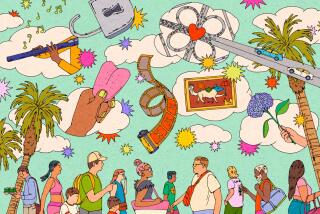Readings : Bean Scene Journal : The young coffeehouse set now has its own magazine. Caffeine is an open forum that publishes prose, poetry, art and more.
You’re driving down the road feeling bad: broke, bored, the President won’t listen to your age group, the New Yorker cold-shoulders your poetry. Where to go for a break?
Caffeine magazine, the new arts forum for everyone--not just eggheads or blowhards or writers everybody’s heard about.
“We’re not politically correct, but we’re equal opportunity,” says publisher Robert Cohen, who started Caffeine from his Woodland Hills home in December, during a bout of unemployment.
Observing the popularity of coffeehouses, which showcase emerging poets and musicians, he decided to offer the same opportunities in print. “There are a lot of people out there who’ve always wanted to write or make art but have to work,” explains Cohen, 24. “I want to give them a reason to keep going.”
Thus his first three issues--the latest of which appears later this month--have featured poetry, prose and photography by little-known Southern California artists as well as java parlor regulars and local literary lights.
Cohen’s partner, 29-year-old R. J. Comer of Northridge, admits that Caffeine’s volunteer staff is no panel of experts. “We just know what we like,” he says.
Still, says May Poppick, co-owner of Emerson’s, a Sherman Oaks coffeehouse that carries Caffeine, “they’ve really targeted their audience appropriately. The poetry’s very young, wacky, wild, angry and hip; the prose is sophisticated. It’s very popular here. We get it in--out it goes.”
A further reason for the popularity of the magazine--which supplements poems and prose with photos, reviews and occasional interviews--is the visual snap-crackle of its graphics. Snips of text run up, down and sideways on the page, superimposed over haunting photos and enigmatic legends. Sometimes it’s a challenge to follow a narrative’s thread, or distinguish a story from a prose poem--difficulties, says Comer, that haven’t seemed to bother writers.
“They love our format,” he reports, calling it “an approximation of the performance phenomenon in poetry now. We can’t take a poem and give it the oomph you can give it onstage, but by manipulating graphics, we come close.”
Both Cohen and Comer point to the influence of cyberpunk magazines and the music of Tom Waits on the look of Caffeine, and to the work of Los Angeles writer Charles Bukowski on its tone and content. Early on, in fact, with just the idea for a publication in his head, Cohen contacted Bukowski and asked him to submit some writing. “I thought he wouldn’t send anything. He did,” Cohen says. He published two Bukowski poems in his first issue and one in the second.
Comparing the coffeehouse scene of the 1950s and ‘60s--during which Beat poets had a great impact on popular culture--with that of today, Cohen and Comer point to a similar “expression vacuum” as a driving force in both eras. Says Cohen: “The old ways of expression weren’t working--especially for people under 35. We needed new ones. And poetry is the most popular way to bitch.”
So popular, in fact, that each issue of Caffeine has done better than the last. Of the three produced since December, all in runs of 15,000, the first was underwritten by Cohen and Comer, and the second and third totally by advertising, which has increased with each issue.
Though it’s hardly a living for its editors--Cohen and Comer work temp jobs to support themselves--they insist on giving it away, at coffeehouses and book and record stores throughout the San Fernando Valley and Los Angeles. Says Comer: “You shouldn’t have to pay for art.”
Readers and contributors agree, judging from how quickly the magazine disappears from the racks, and they appreciate a publication that plasters writers’ names on its cover in hopes of making them famous. Manuscripts, once solicited by flyers in coffee bars, now pour into Caffeine’s post-office box from around the country. Letters commend the staff.
Taking their modest success in stride, Cohen and Comer admit to harboring certain dreams of greatness. These range from eventually paying their staff to opening up a real office to becoming “the Ben and Jerry’s of the publishing world--entrepreneurs with a social conscience.”
In the meantime, they’re content, Cohen says, “to open a dialogue among people around the city and spawn discussions via the written word. Of course, it’s cool to do something that might turn out to be historical.”
WHERE TO GO
* What: Caffeine magazine.
* Address: P.O. Box 4231-306, Woodland Hills 91365.
* Price: Free; yearly subscriptions are $20.
* Call: (818) 340-7853.
More to Read
Sign up for our Book Club newsletter
Get the latest news, events and more from the Los Angeles Times Book Club, and help us get L.A. reading and talking.
You may occasionally receive promotional content from the Los Angeles Times.







